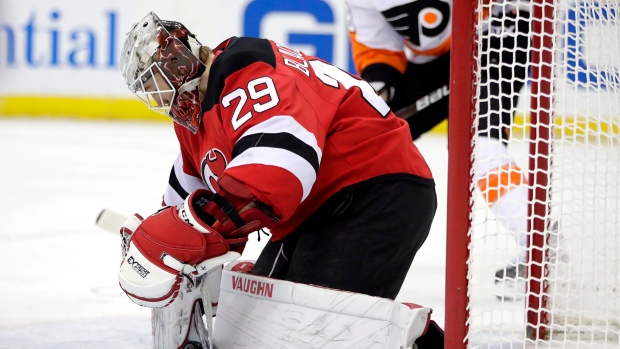Nov 4, 2019
Devils dealing with goaltending dilemma
New Jersey made a big bet on Cory Schneider and Mackenzie Blackwood for the 2019-20 season. So far, it is not paying off, Travis Yost writes.
By Travis Yost

There are a few ways to demoralize an entire organization, but none are more effective than putting AHL-calibre goaltending behind an NHL roster.
The New Jersey Devils are living that nightmare through the first month of the season. The Devils – an interesting upstart team with plenty of firepower sprinkled throughout the lineup – made a big bet on the Cory Schneider and Mackenzie Blackwood combination for the 2019-20 season.
Schneider, whose contract extension kicked in to start the 2015-16 season, has struggled to live up to his $42-million contract. He’s frequently battled injuries, and when he has been healthy enough to stay on the ice, the performance simply hasn’t been there. There were some signs of promise from his play post-abdominal strain last season, but his play has vacillated from bad to awful in his first five appearances this season.
New Jersey’s other platoon goalie, Blackwood, looked to be a promising prospect working his way through the organization. The 22-year-old had a .918 save percentage with six goals saved above average in 23 appearances last year. As a second-round pick, his first NHL season looked to be an extension of what the team saw during his Barrie Colts days. If Schneider went by the wayside, it appeared Blackwood would be able to pick up even more of the slack.
But Blackwood has struggled in his sophomore season, and it’s killing New Jersey. The Devils’ platoon is stopping just 87.2 per cent of shots at 5-on-5 and 86.3 per cent of shots across all situations – both are comfortably dead last in the NHL.
Save percentages are, of course, a function of both goaltending performance and the defensive play of the group in front. It’s hard to carry elite stop rates when your defence is consistently bleeding scoring chances against, and to that end, we must take into account shot quality against.
We can’t adjust all shots for quality because of the NHL’s early season data limitation issues, but we do have high confidence in the data from Oct. 16 onwards.
When we adjust for shot quality, we find that the Devils goaltenders don’t look better in any capacity. In fact, New Jersey not only has the league’s worst stop rates season to date, they also have the biggest delta save percentage – the save percentage we have actually observed from the Schneider/Blackwood duo versus the save percentage we would expect to see when adjusted for predictor variables like shot distance, shot angle, shot type, and the like:
The scary part here is that neither New Jersey goaltender is off to a remotely compelling start. That’s not the case with some other organizations around the league – Minnesota, for example, has seen some impressive early season work from Alex Stalock in relief of the struggling Devan Dubnyk, and Los Angeles has seen a relatively decent effort from backup Jack Campbell in lieu of Jonathan Quick.
Think about the burden this puts on the rest of the skater group. The average NHL team is stopping about 90.8 per cent of shots, while the Devils duo is at 86.3 per cent. That means – all other variables holding equal – the Devils have to generate three shots offensively for every two shots they give up. In a game where even the most puck-dominant teams in the league control about 55 per cent of the shot share, that is a mountain to climb.
This Devils team does seem improved, but erasing that type of goaltending deficit is next to impossible. Getting one of Schneider or Blackwood to rebound in the month of November is critical, or New Jersey’s playoff hopes will be dashed sooner than anyone anticipated.
Data via Hockey Reference and Evolving Hockey

